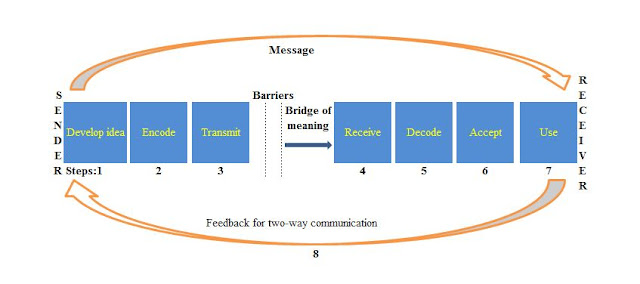COMMUNICATION
Communication is the transfer of information and understanding from one person to another person. It is the way of reaching others by transmitting ideas, facts, thoughts, feelings and values. Its goal is to have the receiver understand the message as it was intended.
Communication always involve two people- a sender and a receiver.
Importance of communication:
Organization cannot exist without communication. If there is no communication, employees cannot know what their coworkers are doing, management cannot receive information inputs, and supervisor and team leaders cannot give instructions. Coordination of work is impossible and the organization will collapse for lack of it. Every act of communication influences the organization.
General purpose of communication can be classified into five broad areas:
- Becoming informed or informing others.
- Evaluating one’s own inputs or other’s performance.
- Directing others or being directed or instructed.
- Influencing others or being influenced.
- Several incidental neutral functions.
Type of communication
- Closed communication
- Open communication
- Two way communication
- Upward communication.
- Downward communication
- Lateral communication
 |
| Communication Process |
TWO WAY COMMUNICATION PROCESS
It is the method by which a sender reaches a receiver with a message. The process always requires eight steps, whether the two parties talk, use hand signals, or employ some advanced technology means of communication. The steps are,
Step-1: Develop an idea- It is to develop an idea that the sender wishes to transmit. This is the key step, because unless there is a worthwhile message, the other entire step is somewhat useless.
Step-2: Encode-Convert the idea into suitable words, charts or other symbols for transmission.
Step-3: Transmit-When the message is finally developed is to transmit it by the method chosen such as memo,, phone call, personal visit.
Step-4: Receive-Transmission allows another person to receive a message. In this step the initiative transfer to the receiver, who tunes in to receive the message? If it is oral, the receiver needs to be a good listener. If the receiver does not function the message is lost.
Step-5: Decode- The message is to be decoded, so that it can be understood. The sender wants the receiver to understand the message exactly as it was sent. Understanding can occur only in a receivers mind.
Step-6: Accept-once the receiver has obtained and decoded a message, that person has the opportunity to accept or reject it. The sender would like the receiver to accept the communication in the manner intended so that activities progress as planned. Some factors affecting the acceptance decision
(1) Perception of the messages accuracy,
(2) The authority and the credibility of the sender
(3) the behavioral implication of the receiver.
Step-7: Use-Another important part in the communication process is the use of information. The receiver may discard it, perform the task as directed, store the information for future, or can do something else. This is a critical action step, and the receiver is largely in control of what to do.
Step- 8: Feedback- When the receiver acknowledge the message and responds to the sender, feedback has occurred. Feedback completes the communication loop, because there is a message flow from the sender to the receiver and back to the sender.
To be continue












0 comments:
Post a Comment
Eagerly waiting for your valuable comments.